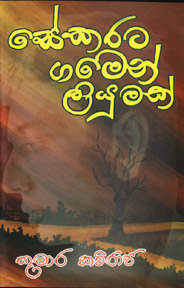Remembering Mahagama Sekara and his halo
 My good friend Mahagama Sekara (1929 - 1976) left a wealth of
invaluable literary creations that need close scrutiny or rediscovery on
the part of the present day literati. His halo of innumerable works
encircles aspects such as poetry, lyrics, novels, short stories, essays,
parables, paintings and cinematic works. His creations, though made an
impact on the literary scene of the yesteryear, had not emerged lasting
impact on the present day due to several factors. My good friend Mahagama Sekara (1929 - 1976) left a wealth of
invaluable literary creations that need close scrutiny or rediscovery on
the part of the present day literati. His halo of innumerable works
encircles aspects such as poetry, lyrics, novels, short stories, essays,
parables, paintings and cinematic works. His creations, though made an
impact on the literary scene of the yesteryear, had not emerged lasting
impact on the present day due to several factors.
This concept of rediscovery will be taken into consideration by the
students of the journalism and communication studies students of the Sri
Lanka Press Council as a creative project on January 14, 2012.
The venue is scheduled at Tunman Handiya, Radawana, well known for
his cinematic work based on his own novel of the same title, and
directed by himself. The diploma students are assigned to study all the
works by Mahagama Sekara to fulfill their rediscovery.
 Sekara emerged into the literary scene via a translation of Conan
Doyle while engaged himself as a teacher of art and literature bearing a
teacher training certificate. But he gradually addressed other branches
such as writing poetry for children and drawing a honourary sketches for
various newspapers and periodicals. Sekara emerged into the literary scene via a translation of Conan
Doyle while engaged himself as a teacher of art and literature bearing a
teacher training certificate. But he gradually addressed other branches
such as writing poetry for children and drawing a honourary sketches for
various newspapers and periodicals.
Having gone through the teaching process for a few years, Sekara was
attached to the then Official Languages Department as a translator. This
was a fitting place for him to acquire more knowledge on literary works.
He excelled in translations, and to his credit I found one of the rare
articles written by Dr Ananda Coomaraswamy translated into Sinhala.
This was yet another point of illumination in his career where he was
drawn towards aesthetics and the study of cross cultural nuances. Sekara
had the good chance of ascending into the media field where he was a
scriptwriter attached to the Sinhala Broadcasting Service.
His joint efforts with Maestro Amaradeva resulted in the birth of
some of the best songs available today via a music programme called
Madhuwanti. Sekara was the lyric writer par excellence and Amaradeva was
the melody maker par excellence. This amalgamation was an epoch opening
event in the media history of our country.
Then comes his period of literary works culminating in such genres as
novel, short story, free verse (resembling Eliot's Wasteland) and the
cinematic works. Sekara was an indefatigable creator who knew the
aspects of the changing village and the process of modernization
remarkably recreated in such works as Nomiyemi and Prabuddha. There were
several other poetic works as well of a different nature. One good
example is Heta Irak Payai.
He was creatively influenced by the orient as well as the occident.
But above all the local folklore was his forte. He had carefully and
sensitively captured the essence of the Sinhala ballads based on Jataka
tales. These works were popular among the masses when he was a young
man. In turn they influenced him for his own creations.
How very wonderful and resourceful!
Last week I received a 76-page poetic work by a contemporary Sinhala
poet named Kumara Kaviraja. To my surprise the work is centred round the
works of Mahagama Sekara, where the poet Kaviraja addresses Sekara in
the form of an intimate letter. The work is titled as Sekarata Gamen
Liyumak (A Letter to Sekara from the Village).
Kaviraja tries to capture the foresights held by Sekara before his
death. It was the foresight of a poet who knew the chnages that would
take place in his hometown, closer to Tunman Handiya. The poet Kaviraja
in his technique of presentation resembles the sensitivity of Sekara,
where a layer of humanism is blended with a layer of human humour.
Kaviraja alludes several scenes, characters and events to those found
in the works of Sekara. This makes the reader feel that Sekara has gone
away from his hometown for a brief period and returned to see the
changes one fine day. Kaviraja alludes to the glory of the nature that
Sekara saw and visualizes in a mood of sorrow the plight of change,
reminding us of the religious concept of transience.
I found the work of Kaviraja as a tribute to Sekara. This paves the
way for our own batch of students to visualize the various nuances of
the past and present.
The image of the creator Sekara is depicted as a vibrant figure a
giant icon, standing on a mount listening to what the poet today has to
say. In fact the work of Kaviraja is just not a letter to Sekara, but a
letter written to mankind from another standpoint. Man has changed in
terms of development. His thoughts and intimacies have changed. Family
patterns have changed.
The creative lessons abound on matters taught by our masters of
sociology, communication and literature.
This indeed is a variant from the common type of poetic writings one
comes across today. As such it deserves a special attention.
[email protected]
|



